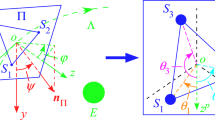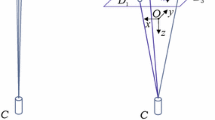Abstract
This study focuses on the global dynamics of a linear tethered satellite formation (LTSF). Specifically, the influence of the initial states of the system on the motion forms and their critical values are presented in detail. First, an approximate but useful model for a high-dimensional nonlinear system is established in a noninertial reference frame, where three satellites and two space tethers are deemed to be particles and massless springs, respectively. Three types of typical in-plane motions, including the motions with spin axes perpendicular to an orbital plane, tangent to the orbit and passing through the Earth center, are examined in conjunction with the suppression of possible out-of-plane motions via control. Then, a Poincaré map is utilized to analyze the stability of the motion. A dynamic parameter domain is proposed to reveal three forms of motions and their critical values numerically. Finally, an equivalent ground experimental system is structured by virtue of the dynamic similarity principle to reproduce the dynamic characteristics of the orbital system.



















Similar content being viewed by others
Data availability
The datasets generated during and/or analyzed during the current study are available from the corresponding author on reasonable request.
Abbreviations
- \(\varvec{DP}\) :
-
Jacobian
- \(d_{0i}\) :
-
Distance between adjacent satellites
- \(d_{g0i}\) :
-
Distance between adjacent simulators
- \(EA\) :
-
Stiffness of the tether
- \({\mathbf{F}}_{gi}^{{\text{c}}}\) :
-
Equivalent control force acting on simulator \(s_{i}\)
- \({\mathbf{F}}_{gi}^{{\text{G}}}\) :
-
Equivalent gravity acting on simulator \(s_{i}\)
- \({\mathbf{F}}_{gi}^{{{\text{IC}}}}\) :
-
Equivalent Coriolis force acting on simulator \(s_{i}\)
- \({\mathbf{F}}_{gi}^{{{\text{Ie}}}}\) :
-
Equivalent carrier inertial force acting on simulator \(s_{i}\)
- \({\mathbf{F}}_{i}^{{\text{c}}}\) :
-
Control force acting on satellite \(S_{i}\)
- \({\mathbf{F}}_{i}^{{{\text{IC}}}}\) :
-
Coriolis force of satellite \(S_{i}\)
- \({\mathbf{F}}_{i}^{{{\text{Ie}}}}\) :
-
Carrier inertial force of satellite \(S_{i}\)
- \({\overline{\mathbf{F}}}_{i}^{{\text{c}}}\) :
-
Dimensionless control force
- \(\varvec{f}\) :
-
Vector field
- \(\overline{G}_{i}\) :
-
Dimensionless gravity
- \({\mathbf{g}}_{i}\) :
-
Gravitational acceleration of satellite \(S_{i}\)
- \(\overline{K}_{0,i}\) :
-
Dimensionless stiffness of the tether
- \(L_{0}\) :
-
Unstrained length of the space tether
- \(L_{g}\) :
-
Current length of the experimental tether
- \({\mathbf{T}}_{i,j}\) :
-
Tension force from satellite \(S_{j}\) acting on \(S_{i}\)
- \(\overline{T}_{i,0}^{{}}\) :
-
Dimensionless tension force
- \(t\) :
-
Orbital time
- \(t_{g}\) :
-
Experimental time
- \({\mathbf{v}}_{i}\) :
-
Relative velocity of satellite \(S_{i}\)
- \(x_{i}\),\(y_{i}\),\(z_{i}\) :
-
Coordinate variable of satellite \(S_{i}\) in the noninertial orbital frame
- \(x_{gi}\),\(y_{gi}\),\(z_{gi}\) :
-
Coordinate variable of simulator \(s_{i}\) in the ground reference frame
- \(\overline{x}_{i}\),\(\overline{y}_{i}\),\(\overline{z}_{i}\) :
-
Dimensionless coordinate variable
- \(\delta_{i,j}\),\(\delta_{gi,j}\) :
-
Sign function
- \(\theta\) :
-
In-plane angle for Situation 1
- \(\theta_{0}\) :
-
Initial in-plane angle for Situation 1
- \(\lambda_{q}\) :
-
Characteristic root of the Jacobian
- \(\mu_{gE}\) :
-
Equivalent gravitational parameter
- \(\mu_{E}\) :
-
Earth gravitational parameter
- \(\nu\) :
-
Orbital true anomaly
- \(\nu_{g}\) :
-
Equivalent true anomaly
- \(\varvec{\xi }\) :
-
Dimensionless vector variable
- \(\varvec{\xi }^{(k)}\) :
-
The kth Poincaré point
- \(L_{g0}\) :
-
Unstrained length of the experimental tether
- \(\overline{L}_{0}\) :
-
Dimensionless unstrained length of the tether
- \(l_{r}\) :
-
Reference length
- \(m\) :
-
Satellite mass
- \(m_{g}\) :
-
Simulator mass
- N :
-
Ascending node
- O :
-
Earth center
- \(o{ - }xyz\) :
-
Noninertial orbital frame
- \(o_{g} { - }x_{g} y_{g} z_{g}\) :
-
Ground reference frame
- \(\varvec{P}\) :
-
Poincaré map
- \({\mathbf{r}}_{gi}\) :
-
Position vector of simulator \(s_{i}\)
- \({\mathbf{r}}_{gO}\) :
-
Corresponding vector to \({\mathbf{r}}_{O}\)
- \({\mathbf{r}}_{i}\) :
-
Position vector of satellite \(S_{i}\)
- \({\mathbf{r}}_{O}\) :
-
Position vector of the Earth center
- \({\overline{\mathbf{r}}}\) :
-
Dimensionless vector to \({\mathbf{r}}_{O}\)
- \(S_{i}\) :
-
Satellite i
- \(s_{i}\) :
-
Simulator i
- \({\mathbf{T}}_{gi,j}\) :
-
Equivalent tether tensile force from simulator \(s_{j}\) acting on \(s_{i}\)
- \(\xi_{1}\),\(\xi_{2}\),\(\xi_{3}\),\(\xi_{4}\) :
-
Dimensionless variable
- \(\varvec{\xi }_{p}\) :
-
Fixed point
- \(\Sigma\) :
-
Poincaré section
- \(\tau\) :
-
Dimensionless time
- \(\varphi\) :
-
In-plane angle for Situation 2
- \(\varphi_{0}\) :
-
Initial in-plane angle for Situation 2
- \(\phi\) :
-
In-plane angle for Situation 3
- \(\phi_{0}\) :
-
Initial in-plane angle for Situation 3
- \(\varvec{\Omega }\) :
-
Orbital angular velocity
- \(\Omega_{g}\) :
-
Equivalent orbital angular velocity
- \(\overline{\Omega }\) :
-
Dimensionless orbital angular velocity
- \(\omega_{gi0}\) :
-
Initial angular velocity of simulator \(s_{i}\)
- \(\varvec{\omega }_{i}\) :
-
Angular velocity of the subsatellite \(S_{i}\)
- \(\omega_{i0}\) :
-
Initial angular velocity of subsatellite \(S_{i}\)
- \(\overline{\omega }_{i0}\) :
-
Initial dimensionless angular velocity
- \({{\text{d}} \mathord{\left/ {\vphantom {{\text{d}} {{\text{d}}t}}} \right. \kern-\nulldelimiterspace} {{\text{d}}t}}\) :
-
Differential operation with respect to orbital time
- \({{\text{d}} \mathord{\left/ {\vphantom {{\text{d}} {{\text{dt}}_{g} }}} \right. \kern-\nulldelimiterspace} {{\text{dt}}_{g} }}\) :
-
Differential operation with respect to experimental time
- \( ( \cdot ) \) :
-
Differential operation with respect to dimensionless time \(\tau\)
References
Kojima, H., Iwashima, H., Trivailo, P.M.: Libration synchronization control of clustered electrodynamic tether system using Kuramoto model. J. Guid. Control. Dyn. 34(3), 706–718 (2011)
Iki, K., Kawamoto, S., Yoshiki, M.: Experiments and numerical simulations of an electrodynamical tether deployment from a spool-type reel using thrusters. Acta Astronaut. 94(1), 318–327 (2014)
Steindl, A.: Optimal control of the deployment (and retrieval) of a tethered satellite under small initial disturbances. Meccanica 49(8), 1879–1885 (2014)
Pang, Z.J., Jin, D.P.: Experimental verification of chaotic control of an underactuated tethered satellite system. Acta Astronaut. 120(1), 287–294 (2016)
Botta, E.M., Sharf, I., Misra, A.K.: Contact dynamics modeling and simulation of tether nets for space-debris capture. J. Guid. Control. Dyn. 40(1), 110–123 (2017)
Xu, S.D., Sun, G.H., Ma, Z.Q., Li, X.L.: Fractional-order fuzzy sliding mode control for the deployment of tethered satellite system under input saturation. IEEE Trans. Aerosp. Electron. Syst. 55(2), 747–756 (2019)
Ma, Z.Q., Huang, P.F.: Nonlinear analysis of discrete-time sliding mode prediction deployment of tethered space robot. IEEE Trans. Industr. Electron. 68(6), 5166–5175 (2021)
Sanmartín, J.R., Lorenzini, E.C., Martinez-Sanchez, M.: Electrodynamic tether applications and constraints. J. Spacecr. Rocket. 47(3), 442–456 (2010)
Peláez, J., Bombardelli, C., Scheeres, D.J.: Dynamics of a tethered observatory at Jupiter. J. Guid. Control. Dyn. 35(1), 195–207 (2012)
Zhang, F., Huang, P.F.: Inertia parameter estimation for a noncooperative target captured by a space tethered system. J. Astronaut. 36(6), 630–639 (2015). ((in Chinese))
Aslanov, V.S., Ledkov, A.S.: Swing principle in tether-assisted return mission from an elliptical orbit. Aerosp. Sci. Technol. 71(1), 156–162 (2017)
Qi, R., Yao, F.Z., Lu, S., Jiang, Z.H.: Stabilization of tethered tug-debris system with residual liquid fuel. J. Guid. Control. Dyn. 44(4), 880–888 (2021)
Li, G.Q., Zhu, Z.H., Shi, G.F.: A novel looped space tether transportation system with multiple climbers for high efficiency. Acta Astronaut. 179(1), 253–265 (2021)
Yu, B.S., Wen, H., Jin, D.P.: Advances in dynamics and control of tethered satellite formations. J. Dyn. Control 13(5), 321–328 (2015). ((in Chinese))
Tan, Z., Bainum P. M.: Tethered satellite constellations in auroral observation mission. In: Proceedings of AIAA/AAS Astrodynamics Specialist Conference and Exhibit, Monterey, USA, 2002.
Topal E., Daybege U.: Dynamics of a trianglar tethered satellite system on a low earth orbit. In: Proceedings of 2nd International Conference on Recent Advances in Space Technologies, Istanbul, Turkey, 2005.
Chung S. -J., Nonlinear control and synchronization of multiple lagrangian systems with application to tethered formation flight spacecraft, Massachusetts Institute of Technology, Doctoral thesis, Cambridge, USA, 2007.
Huang, P.F., Zhang, F., Chen, L., Meng, Z.J., Zhang, Y.Z., Liu, Z.X., Hu, Y.X.: A review of space tether in new applications. Nonlinear Dyn. 94(1), 1–19 (2018)
Kumar, K.D., Yasaka, T.: Dynamics of rotating linear array tethered satellite system. J. Spacecr. Rocket. 42(2), 373–378 (2005)
Williams, P.: Optimal deployment/retrieval of a tethered formation spinning in the orbital plane. J. Spacecr. Rocket. 43(3), 638–650 (2006)
Larsen, M.B., Smith, R.S., Blanke, M.: Modeling of tethered satellite formations using graph theory. Acta Astronaut. 69(7–8), 470–479 (2011)
Avanzini, G., Fedi, M.: Effects of eccentricity of the reference orbit on multi-tethered satellite formations. Acta Astronaut. 94(1), 338–350 (2014)
Cai, Z.Q., Li, X.F., Zhou, H.: Nonlinear dynamics of a rotating triangular tethered satellite formation near libration points. Aerosp. Sci. Technol. 42(1), 384–391 (2015)
Jung, W., Mazzoleni, A.P., Chung, J.: Nonlinear dynamic analysis of a three-body tethered satellite system with deployment/retrieval. Nonlinear Dyn. 82(1), 1127–1144 (2015)
Shi, G.F., Zhu, Z.X., Chen, S.Y., Yuan, J.P., Tang, B.W.: The motion and control of a complex three-body space tethered system. Adv. Space Res. 60(10), 2133–2145 (2017)
Zhai, G., Bi, X.Z., Liang, B.: Optimal deployment of spin-stabilized tethered formations with continuous thrusters. Nonlinear Dyn. 95(1), 2143–2162 (2019)
Fang, G.T., Zhang, Y.Z., Huang, P.F., Zhang, F.: State estimation of double-pyramid tethered satellite formations using only two GPS sensors. Acta Astronaut. 180(1), 507–515 (2021)
Chung, S.-J., Slotine, J.-J.E., Miller, D.W.: Nonlinear model reduction and decentralized control of tethered formation flight. J. Guid. Control. Dyn. 30(2), 390–400 (2007)
Chung, S.-J., Miller, D.W.: Propellant-free control of tethered formation flight, Part 1: linear control and experiment. J. Guid. Control. Dyn. 31(3), 571–584 (2008)
Iki, K., Kawamoto, S., Morino, Y.: Experiments and numerical simulations of an electrodynamic tether deployment from a spool-type reel using thrusters. Acta Astronaut. 94(1), 318–327 (2014)
Mantellato, R., Lorenzini, E.C., Sternberg, D., Roascio, D., Saenz-Otero, A., Zachrau, H.J.: Simulation of a tethered microgravity robot pair and validation on a planar air bearing. Acta Astronaut. 138(1), 579–589 (2017)
Yu, B.S., Huang, Z., Geng, L.L., Jin, D.P.: Stability and ground experiments of a spinning triangular tethered satellite formation on a low earth orbit. Aerosp. Sci. Technol. 92(1), 595–604 (2019)
Forshaw, J.L., Aglietti, G.S., Fellowes, S., Salmon, T., Retat, I., Hall, A., Chabot, T., Pisseloup, A., Tye, D., Bernal, C., Chaumette, F., Pollini, A., Steyn, W.H.: The active space debris removal mission RemoveDebris. Part 1: From concept to launch. Acta Astronautica 168(1), 293–309 (2020)
Yamagiwa, Y., Fujii, T., Nakashima, K., Oshimori, H., Okino, T., Komua, S., Arita, S., Nohmi, M., Ishikawa, Y.: Space experimental results of STARS-C CubeSat to verify tether deployment in orbit. Acta Astronaut. 177(1), 759–770 (2020)
Chai, R.Q., Tsourdos, A., Savvaris, A., Chai, S.C., Xia, Y.Q., Chen, C.L.P.: Six-DOF spacecraft optimal trajectory planning and real-time attitude control: A deep neural network-based approach. IEEE Trans. Neural Netw. Learn. Syst. 31(11), 5005–5013 (2020)
Chai, R.Q., Tsourdos, A., Savvaris, A., Xia, Y.Q., Chai, S.C.: Real-time reentry trajectory planning of hypersonic vehicles: A two-step strategy incorporating fuzzy multi-objective transcription and deep neural network. IEEE Trans. Industr. Electron. 67(8), 6904–6915 (2020)
Acknowledgements
This work was supported by the Natural Science Foundation of China (12072147, 11732006, and 11672125), the Natural Science Foundation of Jiangsu Province of China (BK20211177), the Aviation Science Foundation of China (2020Z063052001), and the Research Fund of State Key Laboratory of Mechanics and Control of Mechanical Structures (MCMS-I-0120G03).
Funding
The authors have not disclosed any funding.
Author information
Authors and Affiliations
Corresponding author
Ethics declarations
Conflict of interest
The authors declare that they have no potential conflicts of interest.
Additional information
Publisher's Note
Springer Nature remains neutral with regard to jurisdictional claims in published maps and institutional affiliations.
Rights and permissions
About this article
Cite this article
Yu, B.S., Ji, K., Wei, Z.T. et al. In-plane global dynamics and ground experiment of a linear tethered formation with three satellites. Nonlinear Dyn 108, 3247–3278 (2022). https://doi.org/10.1007/s11071-022-07403-9
Received:
Accepted:
Published:
Issue Date:
DOI: https://doi.org/10.1007/s11071-022-07403-9














